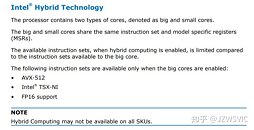
Intel Linux Patch Confirms "Alder Lake" is a Hybrid Core Processor
A Linux kernel patch contributed and signed off by Intel confirms that its upcoming Core "Alder Lake" processor will feature a hybrid core topology, much like Core Hybrid "Lakefield." The patch references "Lakefield" and "Alder Lake" under "Hybrid Core/Atom Processors." The patch possibly gives the Linux kernel awareness of the hybrid core topology, so it can schedule its work between the two types of cores on the silicon accordingly, and avoid rotating between the two core groups. Under the Android project, Linux has been aware of a similar tech from Arm since 2013.
Analogous with Arm big.LITTLE, the Intel Hybrid Core technology involves two kinds of CPU cores on a processor die, the first kind being "high performance," and the second being "low power." On "Lakefield," Intel deployed one "Sunny Cove" high performance core, and four "Tremont" low power cores. The low power cores keep the machine ticking through the vast majority of time when processing workloads requiring the high performance cores aren't present. With "Alder Lake," Intel is expected to scale up this concept, with the silicon rumored to feature eight "Golden Cove" high performance cores, and eight "Gracemont" low power ones. The chip is also expected to feature a Gen12 Xe iGPU.
Analogous with Arm big.LITTLE, the Intel Hybrid Core technology involves two kinds of CPU cores on a processor die, the first kind being "high performance," and the second being "low power." On "Lakefield," Intel deployed one "Sunny Cove" high performance core, and four "Tremont" low power cores. The low power cores keep the machine ticking through the vast majority of time when processing workloads requiring the high performance cores aren't present. With "Alder Lake," Intel is expected to scale up this concept, with the silicon rumored to feature eight "Golden Cove" high performance cores, and eight "Gracemont" low power ones. The chip is also expected to feature a Gen12 Xe iGPU.


















































































